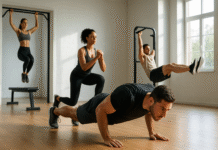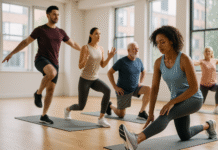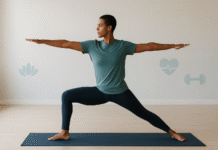You need to be able to move about effortlessly to be healthy and fit in general. If you want to grow better at sports, reduce daily aches, or just have a physique that is more flexible and youthful, working on your flexibility can help a lot. On the other side, a lot of people don’t stretch at all or do it in a way that isn’t very careful, which doesn’t help much and makes them more likely to get hurt.
In This Tutorial
- Why being flexible is crucial and how it works
- Rules for safe stretching
- The five stretches that give you the most bang for your buck
- How to include these stretches into your weekly schedule
- Keeping track of progress and getting beyond plateaus
- Frequently Asked Questions
Why Being Flexible Is Vital to Avoid Being Hurt
- When muscles are tight, they put too much stress on tendons, ligaments, and joints. This makes it more likely that you will get strains, sprains, and other problems from using them too much. When you conduct dynamic exercises, stretching regularly helps keep your muscles the same length and minimizes the chance of microtrauma.
- Better biomechanics and posture
- Muscular imbalances, including tight hip flexors and weak glutes, can cause anterior pelvic tilt, low-back pain, and bad movement patterns. Stretching helps the muscles get back to their best length, which makes the spine and joints perform better.
- Better sports performance
- Having increased range of motion (ROM) in your joints makes it simpler to push yourself and makes your actions smoother, whether you’re running on the track or swinging a tennis racket. According to Harvard Health Publishing, studies have shown that exercising dynamic flexibility practice can help you run faster and jump higher.
- Daily activities and quality of life
- As you get more flexible, actions like tying your shoes, reaching for objects on a high shelf, or playing with your grandkids become easier and less tiring.
- Bringing the body and mind together and lowering stress
- Stretching, especially static and proprioceptive neuromuscular facilitation (PNF) techniques, might help you relax by turning on the parasympathetic nervous system, which lowers cortisol (Mayo Clinic).
Rules for Safe Stretching
- First, warm up.
- Stretching chilly muscles can make them tear a little bit. Do 5 to 10 minutes of light cardiovascular exercise, like walking or riding fast, to warm up your muscles and make them more flexible.
- Get into the stretch slowly.
- Move into each position until you feel some tightness but not discomfort. Static stretches should take 15 to 30 seconds. PNF stretches start with a 5-second contraction and culminate with a 10-second release that goes deeper.
- Take a deep breath.
- As you go farther into the stretch, let out a breath. Controlled breathing helps your muscles relax and lets you stretch more.
- Keep your body in the appropriate location.
- Don’t “cheat” by breaking the rules or finding other ways to make up for it. Keep your core firm and your body in line to work the proper muscle.
- Take it easy and move forward.
- Flexibility work builds on what you’ve already done. Stretch three to four times a week if you can. As you get better at moving, hold the stretches for longer or go deeper.
- Balance is really important.
- To keep your muscles in balance, stretch both your agonist and antagonist muscles, including your quadriceps and hamstrings.
- Pay attention to your body.
- You might be extending too much if you feel sharp or shooting pain. If the pain doesn’t go away, stop straight away and see a doctor.
How to Set Up Your Flexibility Routine: 3 to 5 Days a Week
- Each session lasts from 10 to 20 minutes.
- When:
- As part of your warm-up, you should complete dynamic stretches.
- Do static or PNF stretches after a workout or on a day off.
- Please place your order:
- Everyone should warm up for 5 to 10 minutes.
- Dynamic mobility activities like arm circles and leg swings
- Five stretches you should do every day
- Taking long breaths to calm down
The Five Best Stretches to Make You More Flexible
These five easy stretches will help with the most common areas that are tight. Each one has step-by-step directions, safety tips, and tweaks for folks who are new to it and those who have done it before.
1. Getting up and stretching the hamstrings
Targeted: glutes, hamstrings, and calves
How to Do
- Stand up straight with your feet about the same distance apart as your hips.
- Place your right foot in front of you, with your heel on the ground and your toes pointing up.
- Keep your back straight and bend at the waist. Lean forward until you feel tightness in the back of your right leg.
- Breathe in deeply and hold for 15 to 30 seconds.
- Change sides.
Suggestions and Changes
- Beginner: Bending your front knee a little will make it less intense.
- Advanced: To make the stretch deeper, set your heel on something higher up, like a step, and lean forward even farther.
- Don’t bend your back at the bottom. Let your shoulders go.
2. Do a lunge with a stretch for your hip flexors
Targeted: iliopsoas, quadriceps, and groin
What to Do
- From a standing position, move your right foot forward and bend your knee such that it produces a 90° angle.
- Bring your left knee down toward the floor while keeping your torso straight.
- Bring your pelvis in and clench your buttocks. After that, softly move your hips forward.
- You should feel a pull at the front of your left hip.
- Hold for 15 to 30 seconds, then switch sides.
Advice and Changes
- Beginner: Put a folded mat under your back knee to make it more comfortable.
- Advanced: To extend the hip on the side of your body, lift the arm on the same side as your back leg above your head and bend a little toward the lunging leg.
- Be careful: Don’t allow your front knee go inside; keep it over your ankle.
3. The Seated Butterfly (a stretch for the groin)
Targeted: adductors and inner thigh
How to Do It
- Sit on the floor with your legs bent out to the sides and your feet together.
- Gently press your knees down with your elbows while holding your feet with your hands.
- Keep your chest up and your back straight.
- For 15 to 30 seconds, keep going.
Suggestions and Changes
- Beginner: Sit on a yoga block or a folded blanket to ease lower back pain.
- Advanced: To make the stretch even stronger, lean forward at the hips while keeping your back straight.
- Don’t put too much weight on your knees; don’t make them touch the floor.
4. Stretching the muscles in your shoulder across your body
Targeted: upper back and back deltoids
How to Do
- Stand or sit up straight, with your back straight.
- Put your right arm across your chest so that it is even with your shoulders.
- With your left hand, gently push your right arm toward your body.
- Keep it up for 15 to 30 seconds, then swap arms.
Advice and Changes
- Beginner: Do it while sitting down to make it easier to keep your balance.
- Advanced: Slowly shift your body away from the arm that is extending.
- Don’t hunch your shoulders; keep them down and relaxed.
5. The child’s pose (stretching the back and hips)
Targeted: glutes, lats, erector spinae, and hips
How to Do
- Get down on your hands and knees, like you’re on a table.
- Put your arms out in front of you on the mat and sit back on your heels.
- Put your forehead on the ground or a prop to rest.
- Breathe deeply into your back and let your chest relax.
- Hold it for 30 to 60 seconds.
Suggestions and Changes
- Beginner: Spread your knees apart so that your body has more room.
- Advanced: To stretch your back, put your arms out to one side and then the other.
- If your knees pain, move slowly and carefully. If you need to, put a pillow beneath your knees.
Keeping Track of Progress and Correcting Problems
- Write in a Flexibility Journal: Write down the dates, the stretches you did, how long you held them, and how challenging they were on a scale from 1 to 10.
- Photographic Evidence: Take pictures of your stretch positions every so often to evaluate how your ROM has become better.
How to Get Over Plateaus:
- Show someone how to use PNF procedures (contract-relax methods).
- Add dynamic resistance, such as using a belt to stretch your hamstrings.
- Foam rolling while you stretch is a good technique to break up fascial adhesions.
- It’s crucial to be consistent. Flexibility gains build up over weeks and months, so try to get a little better every time you work out.
Questions and Answers (FAQs)
- How often should I stretch to get as flexible as I can?
Stretch at least three to five times a week, using both dynamic (warm-up) and static (cool-down) approaches. - Can I stretch every day?
Yes, you can stretch as long as you pay attention to how your body feels and don’t push yourself too hard if your muscles are sore or tender. Switch between rigorous workouts and gentler maintenance tasks. - What are the differences between dynamic and static stretching?
- Static: Holding a stretch at the end of its range; it’s ideal to perform this after a workout or on a day off.
- Dynamic: Controlled motions that go through the whole range of motion; excellent as a warm-up to get muscles ready for exercise.
- Is it a bad idea to do some stretching before lifting weights?
Static stretching for a long time can make you weaker and less powerful for a short time. Do dynamic mobility drills before you lift instead of static holds. After you lift, do some static stretches. - When will I know if I’m more flexible?
Depending on how regularly they do the exercises and how flexible they are to begin with, most people see slight changes in 4 to 6 weeks and significant ones in 12 weeks. - Even after I stretch, my muscles still feel tight. What should I do next?
Think about foam rolling, consuming adequate water, and going over your movement patterns with a certified trainer or physical therapist. - Can I stretch with resistance bands?
Yes, bands provide you greater control and can help you stretch deeper without hurting yourself, especially in your shoulders and hamstrings. - Is it natural for your muscles to pain when you stretch?
You might experience some light pain or “good pain,” but if the pain is strong or lasts a long period, you’ve gone too far. Look at your form again after a pause. - Should kids and older individuals stretch in different ways?
Yes, both groups benefit from shorter holds (10–15 seconds), less intensive activity, and tight supervision to avoid getting wounded. - Does stretching help you lose weight?
Stretching doesn’t burn a lot of calories by itself, but it does make you healthier by lowering your chance of injury and making your exercise technique better.
In Short
Touching your toes isn’t the only indicator that you’re more flexible. It’s about letting your body move in all the ways it can so you don’t get hurt and feel better every day. You may make your body stronger, more flexible, and less painful by doing these five stretches every day combined with a solid warm-up, breathing, and consistency. Keep in mind that it takes time to become better. Keep note of how far you’ve come, pay attention to how your body feels, and enjoy every step you take.
References
- Page, P., Ellenbecker, T., & Gilleard, W. “Fascial Manipulation for Sports Performance.” Journal of Bodywork and Movement Therapies, 2015. https://www.jbmtjournal.com/article/S1360-8592(15)00017-0/fulltext
- Mayo Clinic Staff. “Stretching: Focus on Flexibility.” Mayo Clinic, August 21, 2023. https://www.mayoclinic.org/healthy-lifestyle/fitness/in-depth/stretching/art-20047931
- Harvard Health Publishing. “Stretching Exercises.” Harvard Health, May 2024. https://www.health.harvard.edu/staying-healthy/stretching-exercises
- American Council on Exercise. “The Benefits of Stretching.” ACE Fitness Resource Library. https://www.acefitness.org/education-and-resources/lifestyle/exercise-library/equipment/none/position/standing/
- Behm, D. G., & Chaouachi, A. “A Review of the Acute Effects of Static and Dynamic Stretching on Performance.” European Journal of Applied Physiology, 2011. https://link.springer.com/article/10.1007/s00421-011-1879-2




































